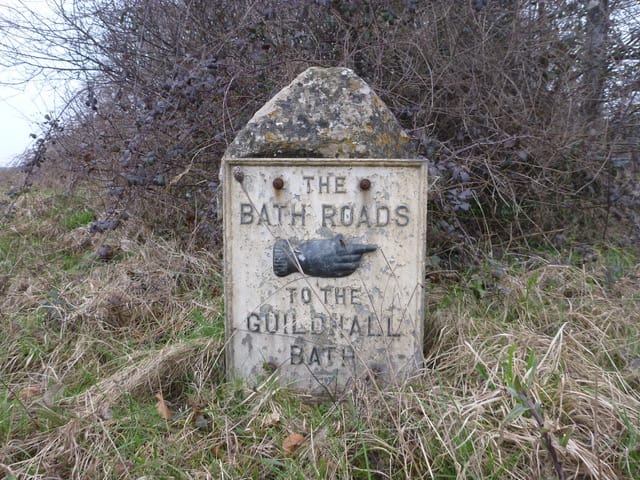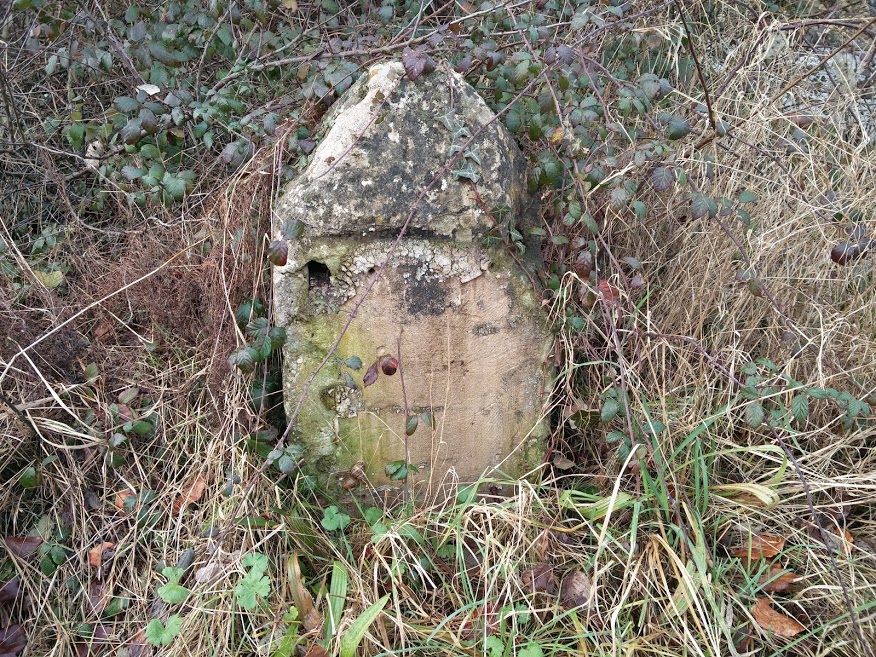Missing at Fiveways by Mark Jenkinson December 2016
We received this distressing email from resident Mark Jenkinson about one of the landmarks of the village.
It is dark morning and night when I pass through Box Fiveways, but it looks in my headlights that the lovely sign-plate on the milestone has gone, leaving just the bare stone beneath on show. Surely it’s not been pinched? If so, I despair. This photo is from 2015 when I walked up to admire it up-close.
I reported the loss to the Milestone Society, who have listed it as WI_LB_BABH07x, Wiltshire (Grade II listed) and are referring the theft to members of the committee, including the member who manages "Theft and Recovery Liaison" in the hope that something might be done. His reply was: "As the milestone is listed, I will pursue the matter with the thefts officer for Historic England, and the Wiltshire Police. We can get it recorded as a crime, and put on the Salvo register, which might make it a bit harder to sell, if indeed it has been stolen for that purpose."
I reported the loss to the Milestone Society, who have listed it as WI_LB_BABH07x, Wiltshire (Grade II listed) and are referring the theft to members of the committee, including the member who manages "Theft and Recovery Liaison" in the hope that something might be done. His reply was: "As the milestone is listed, I will pursue the matter with the thefts officer for Historic England, and the Wiltshire Police. We can get it recorded as a crime, and put on the Salvo register, which might make it a bit harder to sell, if indeed it has been stolen for that purpose."
Bath Roads
The use of the plural, The Bath Roads, on the milepost refers to the various medieval roads from London to Bristol including those going via Chippenham, Neston and Melksham. All the routes met at Fiveways and went through Kingsdown to Bath. We should think of the roads as a variety of tracks going in roughly the right direction where travellers chose the best one for the time of the year.[1] Sometimes the route was an area rather than a track, such as at Kingsdown, and could be up to a mile wide to cope with packhorse trains or flocks of animals.[2] Without signs you followed your nose and hoped that you were going in the right direction.
The use of the plural, The Bath Roads, on the milepost refers to the various medieval roads from London to Bristol including those going via Chippenham, Neston and Melksham. All the routes met at Fiveways and went through Kingsdown to Bath. We should think of the roads as a variety of tracks going in roughly the right direction where travellers chose the best one for the time of the year.[1] Sometimes the route was an area rather than a track, such as at Kingsdown, and could be up to a mile wide to cope with packhorse trains or flocks of animals.[2] Without signs you followed your nose and hoped that you were going in the right direction.
|
Milestones
In 1593 a royal statute standardised a mile as 1,760 yards which was the start of a milepost craze.[3] Milestone markers were useful to indicate when carriage drivers needed to change horses, every ten miles or so, and they became common after 1697 when an act of parliament ordered parishes to erect them.[4] They were especially needed at junctions such as Fiveways crossing, where the important routes to Bath and to Glastonbury intersected. Of course, the signpost shown above isn't the original, which was an engraved stone, but it was a tangible link with the past and we wish we could have it returned please. |
Any further thoughts from readers about this matter would be appreciated. If it was a prank, returning it would be very much appreciated please so that the matter can be rectified.
References
[1] Brian Paul Hindle, Roads, Tracks and Their Interpretation, 1993, B T Batsford Ltd, p.20
[2] Brian Paul Hindle, Roads, Tracks and Their Interpretation, p.20
[3] Sir William Addison, The Old Roads of England, 1980, Harper Collins, p.88
[4] Brian Paul Hindle, Roads, Tracks and Their Interpretation, p.65
[1] Brian Paul Hindle, Roads, Tracks and Their Interpretation, 1993, B T Batsford Ltd, p.20
[2] Brian Paul Hindle, Roads, Tracks and Their Interpretation, p.20
[3] Sir William Addison, The Old Roads of England, 1980, Harper Collins, p.88
[4] Brian Paul Hindle, Roads, Tracks and Their Interpretation, p.65

